Butchering Beef Revisited: Old Meat

If you read my previous post on breaking down a forequarter of beef you may recall that we put some pieces into a ramshackle dry aging chamber so that they could age for a bit before we cut them. Well here we are a little over two months (70 days to be precise) later, and we’re finally ready to break into one of the pieces.
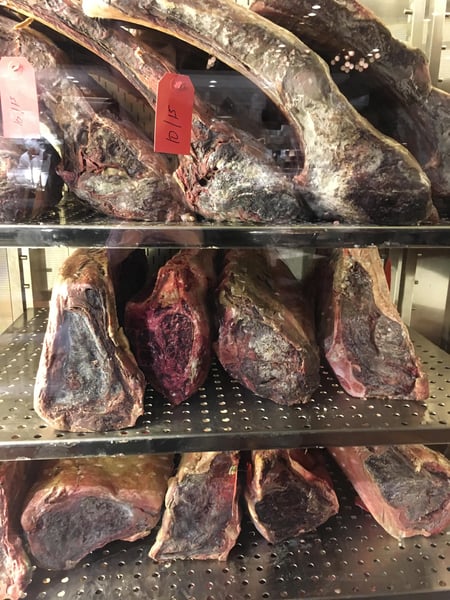
The first of the aging cuts to be trimmed and broken down is going to be the rib. This is the big piece that ribeye steaks are cut from. It's also the cut that gets trimmed down to make a standing rib roast (or prime rib as many know it). Of the major steak cuts (which I would consider to be ribeye, New York strip, porterhouse, t-bone, and filet mignon. If you ask a layperson to name a steak, chances are pretty good it’ll be one of those five.), the ribeye is probably my favorite. I like it because it is tender, but it still has some texture. In fact, it has a good mix of textures in one steak because there are three different muscles that make up one ribeye steak. It also has a good ratio of fat to meat whereas the other cuts mentioned are a bit leaner, and though it's a tender cut, it still has a decent amount of beefy flavor. All of these attributes make it a good candidate for dry aging.
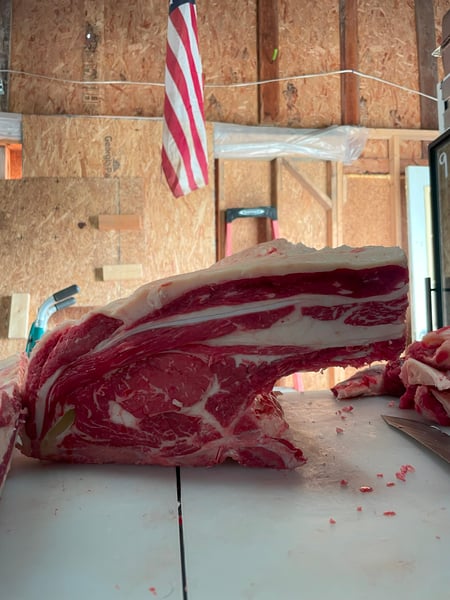 The fresh rib, right after initial cutting
The fresh rib, right after initial cutting
So let's talk a little about dry aging and why I chose this piece specifically to undergo the process. Dry aging, as it sounds, is a process of aging meat (typically beef, but chefs are working more and more with dry aged pork, poultry, fish, and game) whereby no salt is applied and large cuts of meat are allowed to age under specific conditions of temperature and humidity.
Dry aging is employed to improve both the flavor and texture of a piece of meat. So what exactly is happening during the aging process to achieve these goals? First, there’s moisture loss. As the meat ages in a chamber with around 60-70% relative humidity, it slowly dries out (slowly is key here). Not so much that the finished product isn’t juicy once its cooked, but enough to noticeably concentrate the flavor.
In addition to moisture loss, there is also a process called autolysis happening. This is where enzymes that are already present in the meat itself start breaking out down from the inside. This not only further tenderizes the meat, but also breaks down proteins creating more free umami compounds which makes the steak taste meatier and more deeply savory than a fresh cut would. And lastly, there is commonly at least a little fungal and/or bacterial action happening on the outside of the cut while it ages which can contribute a slight funkiness to the finished product.
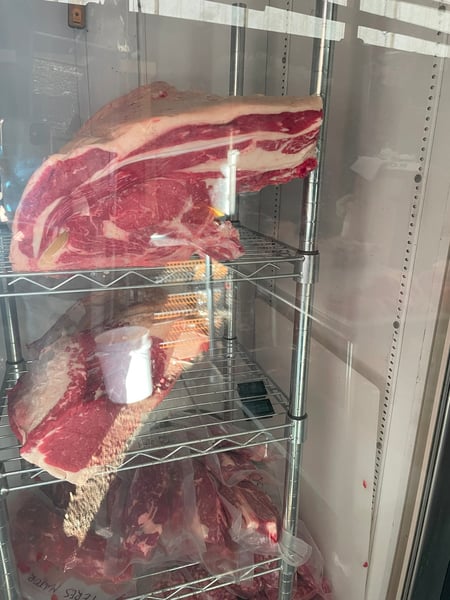 The rib (and brisket below) in the chamber on day one of aging
The rib (and brisket below) in the chamber on day one of aging
The ribeye can benefit from all of these things: the entire piece gets slightly more tender which is welcome, the texture also becomes a bit denser and more luxurious, and of course, the flavor is deepened and concentrated which is where the aging process really shines with a naturally tender cut like ribeye. Indeed the rib section is probably the most commonly dry aged cut of beef for all these reasons, however what’s nice about dry aging yourself is that you can age in a way that you don’t typically find available for retail purchase. Which is to say you can age for a really, really long time.
A typical dry aging period for most commercial operations would be about 21 days. When you see a “dry aged” steak on a steakhouse menu it's likely that it has been aged for around this long. But this is not the limit of aging. Not by a long way. I ended up aging our rib for about 70 days (which I think is the sweet spot for this particular cut), but some people who have passed over the threshold of reasonable human behavior, and have entered a realm of pure chaos where all events occur simultaneously, space and time blend together into an indistinct soup, and causality ceases to have any meaning, have been known to dry age this cut for upwards of 500 days.
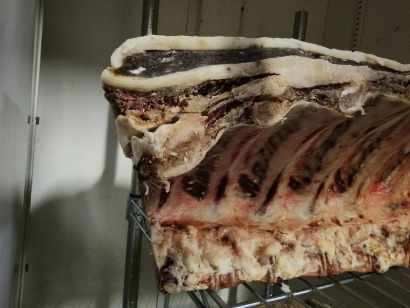 500!
500!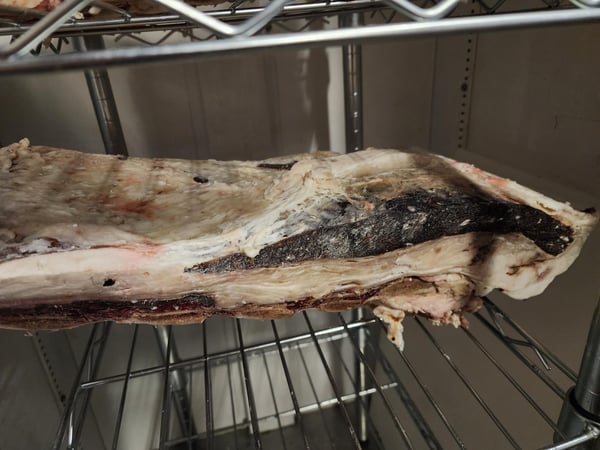
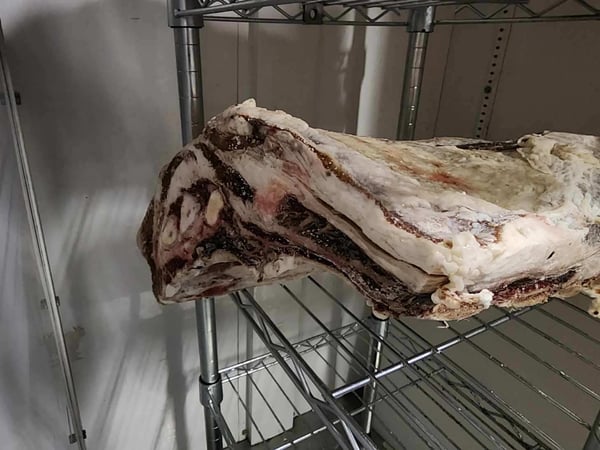 Those same pieces shortly before cutting. About 60 days into aging
Those same pieces shortly before cutting. About 60 days into aging
Now if you just tried to stick any ol’ piece of beef in your fridge for over a year without any control of the environment it would absolutely melt into an odoriferous rotten sludge long before any beneficial aging had taken place. This is because most fridges lack the single most important thing for successful dry aging and that is airflow. Dry aging can be done at typical refrigerator temps and typical refrigerator humidities (its not ideal, but its definitely possible), but if there isn’t excellent airflow around the entire piece of meat (even the bottom), you are on a collision course with rotten meat. In our chamber, we used the built in fan on this commercial reach in fridge unit to provide the airflow, and made sure there was plenty of room around all the aging pieces. We also made sure not to put anything on a tray or in a container. It’s all just sitting on wire shelving which allows air to circulate all over including underneath.
With airflow taken care of, we controlled humidity with a rather inelegant but very effective technique of just dropping a whole bunch of silica gel desiccant packs in the bottom (and monitoring the humidity with a digital gauge), and the temp was controlled by the fridge itself (my buddy works in HVAC so he knows how to just make the fridge be whatever temp he wants. I don’t know how it works; I just cut stuff up). With the chamber sorted pretty much, all we had to do was wait. Other than occasionally wiping off large blooms of mold with vinegar it was pretty much a set it and forget it type of affair.
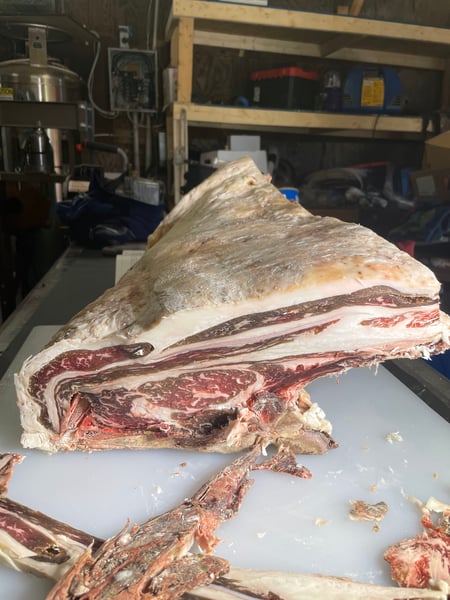
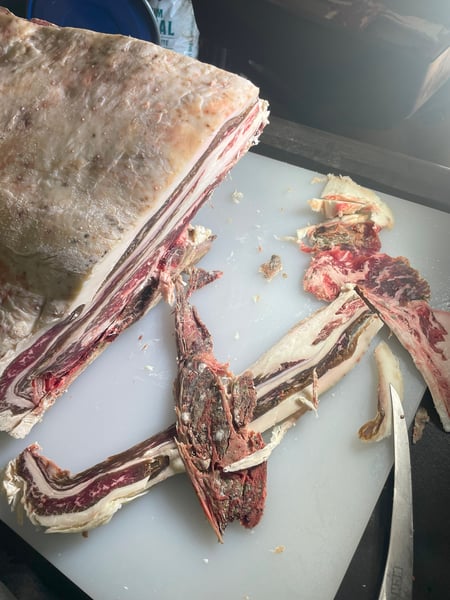 The finished rib getting trimmed
The finished rib getting trimmed
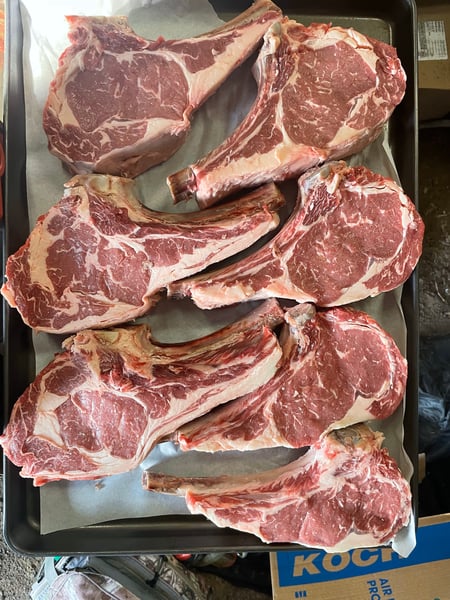 The dry aged steaks fully cut and trimmed. Thrilled with how nicely these turned out.
The dry aged steaks fully cut and trimmed. Thrilled with how nicely these turned out.
So now we can see that with a little extra space and some attention to detail, a simple fridge can be tuned to turn out delicious aged meats of all kinds. For the sake of brevity, I’m going to leave this post here, but there is a good bit more to discuss on this topic so if you’re interested in this sort of thing, then keep your eyes peeled for the next installment. And if this post has inspired you to level up your own butchering skills, then I recommend checking out our upcoming Culinary Boot Camp where we spend an entire day on butchering and meat cookery.

